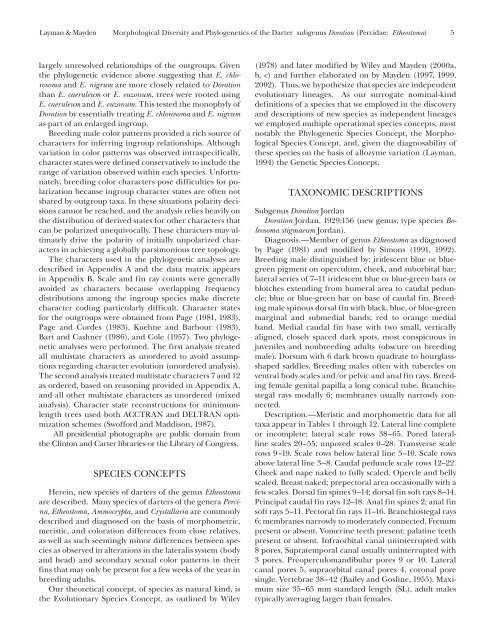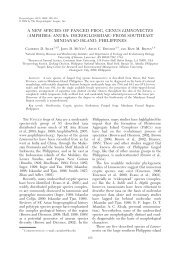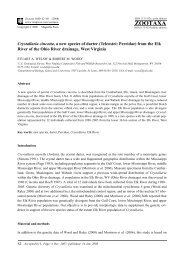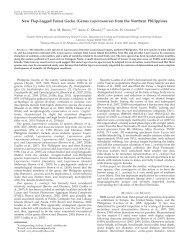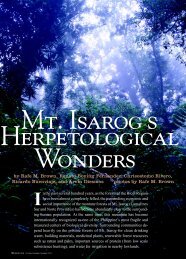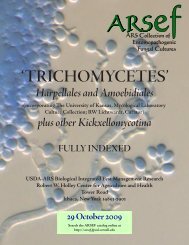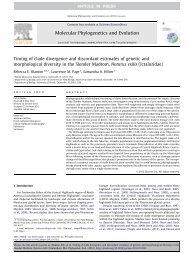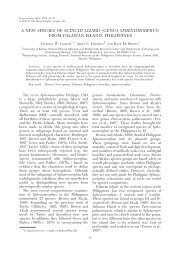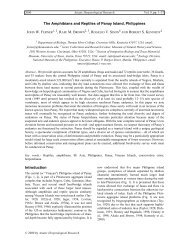(Percidae: Etheostoma), with Descriptions of Five New Species
(Percidae: Etheostoma), with Descriptions of Five New Species
(Percidae: Etheostoma), with Descriptions of Five New Species
- No tags were found...
You also want an ePaper? Increase the reach of your titles
YUMPU automatically turns print PDFs into web optimized ePapers that Google loves.
Layman & Mayden Morphological Diversity and Phylogenetics <strong>of</strong> the Darter subgenus Doration (<strong>Percidae</strong>: <strong>Etheostoma</strong>) largely unresolved relationships <strong>of</strong> the outgroups. Giventhe phylogenetic evidence above suggesting that E. chlorosomaand E. nigrum are more closely related to Dorationthan E. caeruleum or E. euzonum, trees were rooted usingE. caeruleum and E. euzonum. This tested the monophyly <strong>of</strong>Doration by essentially treating E. chlorosoma and E. nigrumas part <strong>of</strong> an enlarged ingroup.Breeding male color patterns provided a rich source <strong>of</strong>characters for inferring ingroup relationships. Althoughvariation in color patterns was observed intraspecifically,character states were defined conservatively to include therange <strong>of</strong> variation observed <strong>with</strong>in each species. Unfortunately,breeding color characters pose difficulties for polarizationbecause ingroup character states are <strong>of</strong>ten notshared by outgroup taxa. In these situations polarity decisionscannot be reached, and the analysis relies heavily onthe distribution <strong>of</strong> derived states for other characters thatcan be polarized unequivocally. These characters may ultimatelydrive the polarity <strong>of</strong> initially unpolarized charactersin achieving a globally parsimonious tree topology.The characters used in the phylogenetic analyses aredescribed in Appendix A and the data matrix appearsin Appendix B. Scale and fin ray counts were generallyavoided as characters because overlapping frequencydistributions among the ingroup species make discretecharacter coding particularly difficult. Character statesfor the outgroups were obtained from Page (1981, 1983),Page and Cordes (1983), Kuehne and Barbour (1983),Bart and Cashner (1986), and Cole (1957). Two phylogeneticanalyses were performed. The first analysis treatedall multistate characters as unordered to avoid assumptionsregarding character evolution (unordered analysis).The second analysis treated multistate characters 7 and 12as ordered, based on reasoning provided in Appendix A,and all other multistate characters as unordered (mixedanalysis). Character state reconstructions for minimumlengthtrees used both ACCTRAN and DELTRAN optimizationschemes (Sw<strong>of</strong>ford and Maddison, 1987).All presidential photographs are public domain fromthe Clinton and Carter libraries or the Library <strong>of</strong> Congress.<strong>Species</strong> ConceptsHerein, new species <strong>of</strong> darters <strong>of</strong> the genus <strong>Etheostoma</strong>are described. Many species <strong>of</strong> darters <strong>of</strong> the genera Percina,<strong>Etheostoma</strong>, Ammocrypta, and Crystallaria are commonlydescribed and diagnosed on the basis <strong>of</strong> morphometric,meristic, and coloration differences from close relatives,as well as such seemingly minor differences between speciesas observed in alterations in the lateralis system (bodyand head) and secondary sexual color patterns in theirfins that may only be present for a few weeks <strong>of</strong> the year inbreeding adults.Our theoretical concept, <strong>of</strong> species as natural kind, isthe Evolutionary <strong>Species</strong> Concept, as outlined by Wiley(1978) and later modified by Wiley and Mayden (2000a,b, c) and further elaborated on by Mayden (1997, 1999,2002). Thus, we hypothesize that species are independentevolutionary lineages. As our surrogate nominal-kinddefinitions <strong>of</strong> a species that we employed in the discoveryand descriptions <strong>of</strong> new species as independent lineageswe employed multiple operational species concepts, mostnotably the Phylogenetic <strong>Species</strong> Concept, the Morphological<strong>Species</strong> Concept, and, given the diagnosability <strong>of</strong>these species on the basis <strong>of</strong> allozyme variation (Layman,1994) the Genetic <strong>Species</strong> Concept.TAXONOMIC DESCRIPTIONSSubgenus Doration JordanDoration Jordan, 1929:156 (new genus, type species Boleosomastigmaeum Jordan).Diagnosis.—Member <strong>of</strong> genus <strong>Etheostoma</strong> as diagnosedby Page (1981) and modified by Simons (1991, 1992).Breeding male distinguished by: iridescent blue or bluegreenpigment on operculum, cheek, and suborbital bar;lateral series <strong>of</strong> 7–11 iridescent blue or blue-green bars orblotches extending from humeral area to caudal peduncle;blue or blue-green bar on base <strong>of</strong> caudal fin. Breedingmale spinous dorsal fin <strong>with</strong> black, blue, or blue-greenmarginal and submedial bands; red to orange medialband. Medial caudal fin base <strong>with</strong> two small, verticallyaligned, closely spaced dark spots, most conspicuous injuveniles and nonbreeding adults (obscure on breedingmale). Dorsum <strong>with</strong> 6 dark brown quadrate to hourglassshapedsaddles. Breeding males <strong>of</strong>ten <strong>with</strong> tubercles onventral body scales and/or pelvic and anal fin rays. Breedingfemale genital papilla a long conical tube. Branchiostegalrays modally 6; membranes usually narrowly connected.Description.—Meristic and morphometric data for alltaxa appear in Tables 1 through 12. Lateral line completeor incomplete; lateral scale rows 38–65. Pored laterallinescales 20–55; unpored scales 0–28. Transverse scalerows 9–19. Scale rows below lateral line 5–10. Scale rowsabove lateral line 3–8. Caudal peduncle scale rows 12–22.Cheek and nape naked to fully scaled. Opercle and bellyscaled. Breast naked; prepectoral area occasionally <strong>with</strong> afew scales. Dorsal fin spines 9–14; dorsal fin s<strong>of</strong>t rays 8–14.Principal caudal fin rays 12–18. Anal fin spines 2; anal fins<strong>of</strong>t rays 5–11. Pectoral fin rays 11–16. Branchiostegal rays6; membranes narrowly to moderately connected. Frenumpresent or absent. Vomerine teeth present; palatine teethpresent or absent. Infraorbital canal uninterrupted <strong>with</strong>8 pores. Supratemporal canal usually uninterrupted <strong>with</strong>3 pores. Preoperculomandibular pores 9 or 10. Lateralcanal pores 5, supraorbital canal pores 4, coronal poresingle. Vertebrae 38–42 (Bailey and Gosline, 1955). Maximumsize 35–65 mm standard length (SL), adult malestypically averaging larger than females.


